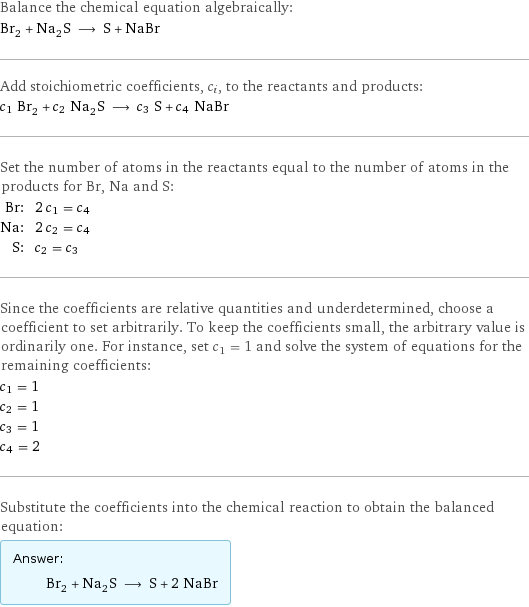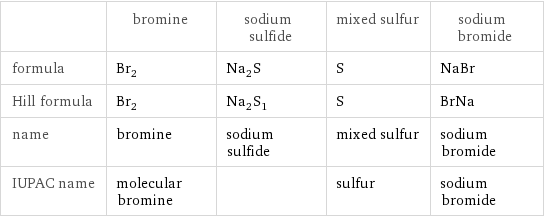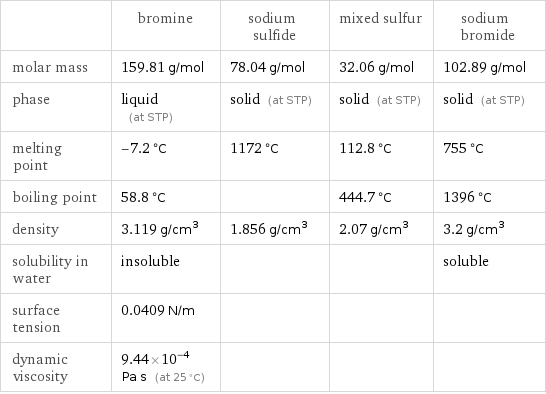Input interpretation

Br_2 bromine + Na_2S sodium sulfide ⟶ S mixed sulfur + NaBr sodium bromide
Balanced equation

Balance the chemical equation algebraically: Br_2 + Na_2S ⟶ S + NaBr Add stoichiometric coefficients, c_i, to the reactants and products: c_1 Br_2 + c_2 Na_2S ⟶ c_3 S + c_4 NaBr Set the number of atoms in the reactants equal to the number of atoms in the products for Br, Na and S: Br: | 2 c_1 = c_4 Na: | 2 c_2 = c_4 S: | c_2 = c_3 Since the coefficients are relative quantities and underdetermined, choose a coefficient to set arbitrarily. To keep the coefficients small, the arbitrary value is ordinarily one. For instance, set c_1 = 1 and solve the system of equations for the remaining coefficients: c_1 = 1 c_2 = 1 c_3 = 1 c_4 = 2 Substitute the coefficients into the chemical reaction to obtain the balanced equation: Answer: | | Br_2 + Na_2S ⟶ S + 2 NaBr
Structures

+ ⟶ +
Names

bromine + sodium sulfide ⟶ mixed sulfur + sodium bromide
Equilibrium constant
![Construct the equilibrium constant, K, expression for: Br_2 + Na_2S ⟶ S + NaBr Plan: • Balance the chemical equation. • Determine the stoichiometric numbers. • Assemble the activity expression for each chemical species. • Use the activity expressions to build the equilibrium constant expression. Write the balanced chemical equation: Br_2 + Na_2S ⟶ S + 2 NaBr Assign stoichiometric numbers, ν_i, using the stoichiometric coefficients, c_i, from the balanced chemical equation in the following manner: ν_i = -c_i for reactants and ν_i = c_i for products: chemical species | c_i | ν_i Br_2 | 1 | -1 Na_2S | 1 | -1 S | 1 | 1 NaBr | 2 | 2 Assemble the activity expressions accounting for the state of matter and ν_i: chemical species | c_i | ν_i | activity expression Br_2 | 1 | -1 | ([Br2])^(-1) Na_2S | 1 | -1 | ([Na2S])^(-1) S | 1 | 1 | [S] NaBr | 2 | 2 | ([NaBr])^2 The equilibrium constant symbol in the concentration basis is: K_c Mulitply the activity expressions to arrive at the K_c expression: Answer: | | K_c = ([Br2])^(-1) ([Na2S])^(-1) [S] ([NaBr])^2 = ([S] ([NaBr])^2)/([Br2] [Na2S])](../image_source/cf1e687116e3f1380b80e80182909001.png)
Construct the equilibrium constant, K, expression for: Br_2 + Na_2S ⟶ S + NaBr Plan: • Balance the chemical equation. • Determine the stoichiometric numbers. • Assemble the activity expression for each chemical species. • Use the activity expressions to build the equilibrium constant expression. Write the balanced chemical equation: Br_2 + Na_2S ⟶ S + 2 NaBr Assign stoichiometric numbers, ν_i, using the stoichiometric coefficients, c_i, from the balanced chemical equation in the following manner: ν_i = -c_i for reactants and ν_i = c_i for products: chemical species | c_i | ν_i Br_2 | 1 | -1 Na_2S | 1 | -1 S | 1 | 1 NaBr | 2 | 2 Assemble the activity expressions accounting for the state of matter and ν_i: chemical species | c_i | ν_i | activity expression Br_2 | 1 | -1 | ([Br2])^(-1) Na_2S | 1 | -1 | ([Na2S])^(-1) S | 1 | 1 | [S] NaBr | 2 | 2 | ([NaBr])^2 The equilibrium constant symbol in the concentration basis is: K_c Mulitply the activity expressions to arrive at the K_c expression: Answer: | | K_c = ([Br2])^(-1) ([Na2S])^(-1) [S] ([NaBr])^2 = ([S] ([NaBr])^2)/([Br2] [Na2S])
Rate of reaction
![Construct the rate of reaction expression for: Br_2 + Na_2S ⟶ S + NaBr Plan: • Balance the chemical equation. • Determine the stoichiometric numbers. • Assemble the rate term for each chemical species. • Write the rate of reaction expression. Write the balanced chemical equation: Br_2 + Na_2S ⟶ S + 2 NaBr Assign stoichiometric numbers, ν_i, using the stoichiometric coefficients, c_i, from the balanced chemical equation in the following manner: ν_i = -c_i for reactants and ν_i = c_i for products: chemical species | c_i | ν_i Br_2 | 1 | -1 Na_2S | 1 | -1 S | 1 | 1 NaBr | 2 | 2 The rate term for each chemical species, B_i, is 1/ν_i(Δ[B_i])/(Δt) where [B_i] is the amount concentration and t is time: chemical species | c_i | ν_i | rate term Br_2 | 1 | -1 | -(Δ[Br2])/(Δt) Na_2S | 1 | -1 | -(Δ[Na2S])/(Δt) S | 1 | 1 | (Δ[S])/(Δt) NaBr | 2 | 2 | 1/2 (Δ[NaBr])/(Δt) (for infinitesimal rate of change, replace Δ with d) Set the rate terms equal to each other to arrive at the rate expression: Answer: | | rate = -(Δ[Br2])/(Δt) = -(Δ[Na2S])/(Δt) = (Δ[S])/(Δt) = 1/2 (Δ[NaBr])/(Δt) (assuming constant volume and no accumulation of intermediates or side products)](../image_source/6c17d33a0425bd1da2d8ac359fa21594.png)
Construct the rate of reaction expression for: Br_2 + Na_2S ⟶ S + NaBr Plan: • Balance the chemical equation. • Determine the stoichiometric numbers. • Assemble the rate term for each chemical species. • Write the rate of reaction expression. Write the balanced chemical equation: Br_2 + Na_2S ⟶ S + 2 NaBr Assign stoichiometric numbers, ν_i, using the stoichiometric coefficients, c_i, from the balanced chemical equation in the following manner: ν_i = -c_i for reactants and ν_i = c_i for products: chemical species | c_i | ν_i Br_2 | 1 | -1 Na_2S | 1 | -1 S | 1 | 1 NaBr | 2 | 2 The rate term for each chemical species, B_i, is 1/ν_i(Δ[B_i])/(Δt) where [B_i] is the amount concentration and t is time: chemical species | c_i | ν_i | rate term Br_2 | 1 | -1 | -(Δ[Br2])/(Δt) Na_2S | 1 | -1 | -(Δ[Na2S])/(Δt) S | 1 | 1 | (Δ[S])/(Δt) NaBr | 2 | 2 | 1/2 (Δ[NaBr])/(Δt) (for infinitesimal rate of change, replace Δ with d) Set the rate terms equal to each other to arrive at the rate expression: Answer: | | rate = -(Δ[Br2])/(Δt) = -(Δ[Na2S])/(Δt) = (Δ[S])/(Δt) = 1/2 (Δ[NaBr])/(Δt) (assuming constant volume and no accumulation of intermediates or side products)
Chemical names and formulas

| bromine | sodium sulfide | mixed sulfur | sodium bromide formula | Br_2 | Na_2S | S | NaBr Hill formula | Br_2 | Na_2S_1 | S | BrNa name | bromine | sodium sulfide | mixed sulfur | sodium bromide IUPAC name | molecular bromine | | sulfur | sodium bromide
Substance properties

| bromine | sodium sulfide | mixed sulfur | sodium bromide molar mass | 159.81 g/mol | 78.04 g/mol | 32.06 g/mol | 102.89 g/mol phase | liquid (at STP) | solid (at STP) | solid (at STP) | solid (at STP) melting point | -7.2 °C | 1172 °C | 112.8 °C | 755 °C boiling point | 58.8 °C | | 444.7 °C | 1396 °C density | 3.119 g/cm^3 | 1.856 g/cm^3 | 2.07 g/cm^3 | 3.2 g/cm^3 solubility in water | insoluble | | | soluble surface tension | 0.0409 N/m | | | dynamic viscosity | 9.44×10^-4 Pa s (at 25 °C) | | |
Units
